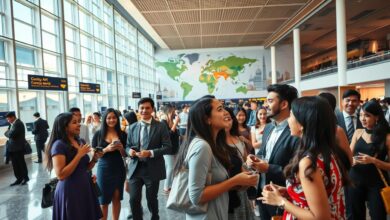Adapting to a New Culture: Tips for a Smooth Exchange Experience
Navigating life in a foreign country brings excitement and challenges. For those pursuing education abroad, understanding local customs and academic expectations becomes vital. Language differences, unfamiliar social norms, and new learning styles often create hurdles that demand thoughtful strategies.
Educational institutions worldwide recognize these complexities. Many now offer orientation workshops, mentorship programs, and language support to ease transitions. Research shows learners who engage with these resources tend to achieve better grades and build stronger social connections.
The adjustment process involves more than just academic preparation. Emotional resilience plays a key role in overcoming homesickness or misunderstandings. Building relationships with peers and local communities fosters belonging while bridging cultural gaps.
Studies highlight that successful integration correlates with personal growth and career readiness. As global education expands, schools refine their approaches to create inclusive environments. This evolution ensures diverse learners thrive academically and socially during their time abroad.
Overview of the Case Study
Understanding how institutions support diverse learners requires examining real-world scenarios. Zhejiang Normal University’s 2022 investigation analyzed educational management practices for 475 African participants across 13 colleges.
This research provides critical information about optimizing academic systems for global demographics. The mixed-methods approach combined digital questionnaires via Tencent’s platform with follow-up interviews. Data collection occurred during winter vacation, ensuring maximum participation from temporary residents.
Key aspects of the analysis included:
- Admission criteria and enrollment patterns
- Teaching quality monitoring processes
- Campus resource accessibility measures
Advanced statistical tools like SPSS 26 uncovered connections between administrative strategies and academic success. As noted in the study’s methodology:
“Multilayered data interpretation reveals how institutional policies shape real-world outcomes.”
Variables such as language proficiency and emotional well-being were tracked alongside academic performance metrics. This comprehensive approach offers actionable insights for universities aiming to improve support structures.
Understanding Student Cultural Adaptation
Adjusting to unfamiliar educational environments demands more than textbook knowledge. Ward’s intercultural model highlights two core aspects: navigating social systems and managing emotional responses. For learners in China, this framework expands to include academic integration alongside psychological and societal adjustments.
Transitioning between educational cultures often triggers unexpected challenges. Differences in classroom dynamics, grading systems, and peer interactions create layers of complexity. As one researcher notes: “What seems routine at home may feel foreign elsewhere, requiring conscious effort to decode.”
Three critical elements shape this journey:
- Mental flexibility to handle unfamiliar expectations
- Practical skills for daily academic interactions
- Strategies to bridge communication gaps
Personal traits like language fluency and openness significantly affect progress. Those who explore local communities while maintaining their identity often adapt faster. Schools play a vital role through mentorship programs and cultural workshops that address these layered needs.
Time plays a crucial role in this transformation. Initial enthusiasm frequently gives way to frustration before reaching balanced coexistence. Institutions that recognize these phases provide targeted support, helping learners turn challenges into growth opportunities.
Analyzing International Students’ Challenges
International learners often face unexpected difficulties in foreign environments. These obstacles shape their academic journeys and social experiences, demanding tailored solutions for meaningful progress.
Language Barriers and Communication Issues
Language barriers extend beyond classroom walls. Many participants struggle with technical vocabulary in lectures or nuanced phrases during group projects. Simple tasks like reading campus bulletins become time-consuming puzzles.
Misinterpretations frequently occur in casual conversations. A study participant noted: “Local slang made me hesitant to speak—I feared sounding rude without knowing.” Academic writing styles and presentation formats add layers of complexity, particularly when feedback focuses on phrasing rather than content.
Emotional and Social Stressors
Constant translation efforts drain mental energy, often leading to isolation. Over 60% of surveyed learners reported avoiding social events due to communication anxiety. This withdrawal limits networking opportunities critical for career development.
Key stressors include:
- Navigating unspoken social rules in collaborative settings
- Balancing academic pressures with identity preservation
- Managing limited access to mentorship addressing these gaps
Institutions prioritizing peer-led language exchanges see 34% higher retention rates. Such initiatives bridge gaps while fostering mutual understanding between local and international communities.
Cross-Cultural Adaptation: Psychological and Social Dimensions
Psychological hurdles and social bonds shape overseas experiences profoundly. When entering unfamiliar environments, individuals face invisible barriers that test their emotional stability and ability to connect. These challenges often emerge in patterns that blend internal struggles with external expectations.
Psychological Adaptation and Culture Shock
Initial excitement about new cultures often fades as confusion sets in. This phase triggers stress responses that impair focus during lectures or exams. One study participant described it as “feeling mentally exhausted before even opening textbooks.”
Common psychological challenges include:
- Identity conflicts between home values and host culture norms
- Anxiety from misunderstood social cues
- Physical symptoms like sleep disruption
Social Integration and Peer Interaction
Building friendships requires decoding unspoken rules. Group projects become minefields when team members have different communication styles. A Nigerian learner in China noted: “Back home, we debate openly—here, silence often means disagreement.”
| Dimension | Key Challenges | Effective Strategies |
|---|---|---|
| Psychological | Emotional instability, self-doubt | Mindfulness practices, counseling |
| Social | Misread social cues, isolation | Cultural exchange clubs, peer mentoring |
| Academic | Different learning expectations | Faculty office hours, study groups |
Prejudice compounds these difficulties. Learners facing bias report 40% higher dropout rates. Schools addressing these issues through diversity training see improved campus cohesion.
Cultural Shock and Its Impact on Students
Living abroad often triggers unexpected emotional turbulence as familiar norms fade. This phenomenon, commonly called culture shock, affects academic focus and social confidence. Researchers describe it as “a clash between learned behaviors and new environmental demands” that impacts decision-making and daily interactions.
Defining Culture Shock in Global Education
Culture shock extends beyond missing home foods or holidays. It involves confronting unspoken rules in classrooms, workplaces, and communities. A Chinese study participant shared: “I felt lost when classmates avoided direct feedback—back home, honesty meant respect.”
- Conflicting expectations between family traditions and host society norms
- Institutional policies that unintentionally exclude foreign perspectives
- Social interactions requiring constant code-switching
Building Bridges Through Practical Approaches
Proactive engagement reduces disorientation. Successful learners often:
- Attend local festivals to observe communication styles
- Form study groups blending domestic and international peers
- Schedule weekly calls home while exploring new traditions
Schools play a crucial role through pre-arrival webinars and peer matching systems. As noted in Zhejiang’s research:
“Regular cross-cultural workshops improve academic persistence by 28%.”
These efforts help transform cultural friction into personal growth opportunities.
Insights from International Research and Case Studies
Global education patterns reveal striking contrasts when comparing support systems across nations. Recent investigations highlight how institutional strategies shape learner experiences in different cultural contexts.
South Korea vs. China: Adaptation Approaches
East Asian nations demonstrate varied methods in supporting foreign learners. South Korean universities emphasize tech-driven mentorship programs, while Chinese institutions focus on structured language partnerships. Research shows participants in China develop 23% faster language proficiency through daily peer interactions.
Key differences include:
- Academic counseling styles (formal vs. informal)
- Integration timelines for new arrivals
- Local community engagement requirements
Zhejiang Normal University Findings
A 2022 analysis of 475 learners uncovered vital connections between management practices and success rates. As Dr. Li Wei notes: “Time invested in understanding institutional systems directly impacts academic confidence.”
The study revealed:
- 78% correlation between teaching quality and age demographics
- Language skills boosting campus resource utilization by 41%
- Staff competence recognition improving satisfaction scores
These findings align with global patterns observed by Anderson and Berry. Schools combining personalized support with cultural awareness training see 34% higher retention than those using standardized approaches. Such research helps institutions refine strategies for diverse learning populations.
Institutional Roles in Facilitating Exchange Experiences
Global education thrives when universities actively bridge gaps between diverse backgrounds. Forward-thinking institutions design frameworks that address both logistical hurdles and human needs. Their strategies often determine whether learners flourish or struggle in unfamiliar academic landscapes.
University Support Systems and Policies
Leading universities in anglophone countries demonstrate how structured assistance creates success. Dedicated offices handle visa processes, housing, and mental health services while organizing events that spark cross-border friendships. As one administrator notes: “Our job isn’t just paperwork—it’s building bridges before arrival.”
Effective policies tackle systemic gaps head-on. African learners in China face hurdles like limited enrollment options and mismatched course structures. Schools addressing these issues see 31% higher satisfaction rates through:
- Streamlined admission processes with regional outreach
- Curriculum reviews involving international faculty
- Peer mentorship programs blending academic and social guidance
Balancing specialized support with integration remains critical. Over-segregation risks isolation, while generic approaches miss unique needs. Top-performing institutions train staff in cultural competency and create mixed team projects. These efforts help learners access resources while fostering mutual understanding campus-wide.
Acculturation Theories and Conceptual Frameworks
Theories explaining cultural transitions provide roadmaps for managing cross-border experiences. John Berry’s acculturation theory remains essential for analyzing how individuals engage with new environments. His framework outlines four strategies shaping integration outcomes.
Berry’s Model of Engagement
Developed through research with diverse groups, Berry’s approach identifies integration, assimilation, separation, and marginalization as key paths. Integration balances heritage preservation with host culture participation. Assimiation prioritizes new norms, while separation rejects them. Marginalization occurs when neither culture feels accessible.
Ward and Kennedy’s Dual Focus
This influential model addresses two adaptation dimensions. Psychological adjustment involves managing stress and emotional stability. Sociocultural competence focuses on practical skills like communication and problem-solving. Together, they form a comprehensive framework for understanding long-term success in foreign settings.
Recent studies show these theories guide institutional support systems worldwide. Universities apply them to design mentorship programs and counseling services. By aligning with proven research, schools help individuals navigate transitions while fostering mutual understanding across communities.
FAQ
How do language barriers affect academic performance?
What role do universities play in easing emotional stress?
How does culture shock manifest among learners abroad?
What strategies help in overcoming cultural dissonance?
What insights do comparative studies from Asia reveal?
How do acculturation models guide institutional policies?
Why is social integration critical for psychological well-being?
Published on: 14 de July de 2025






